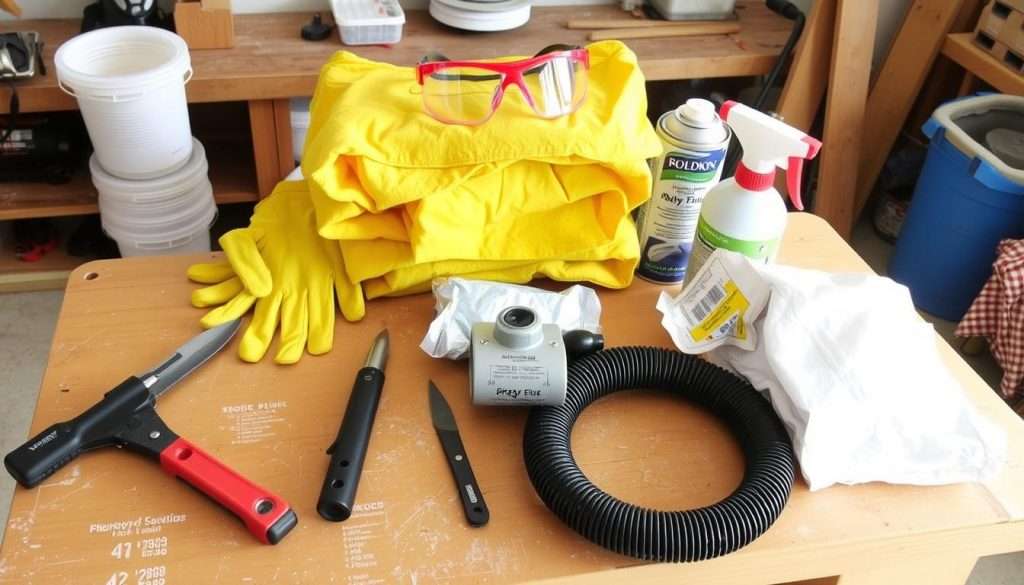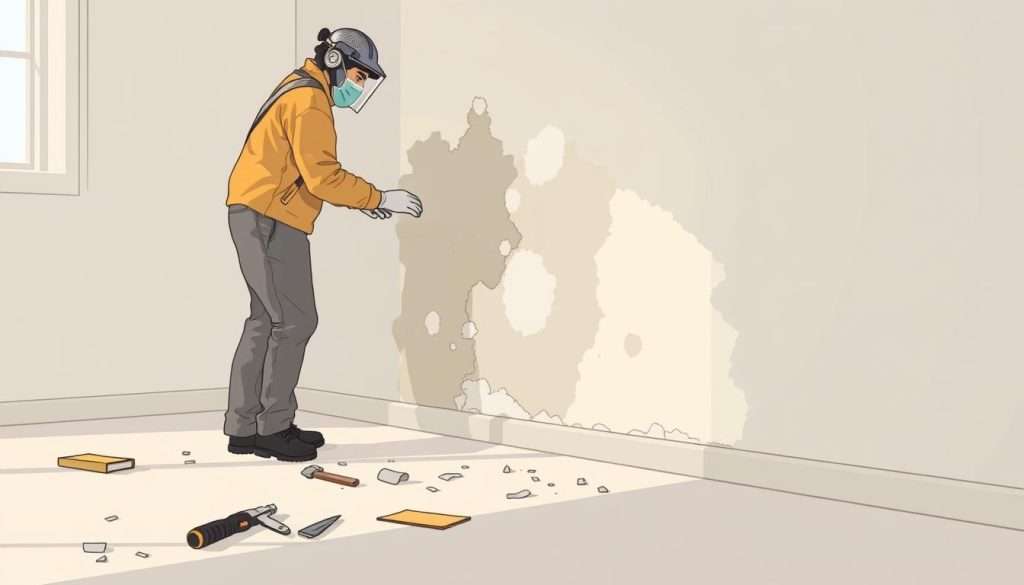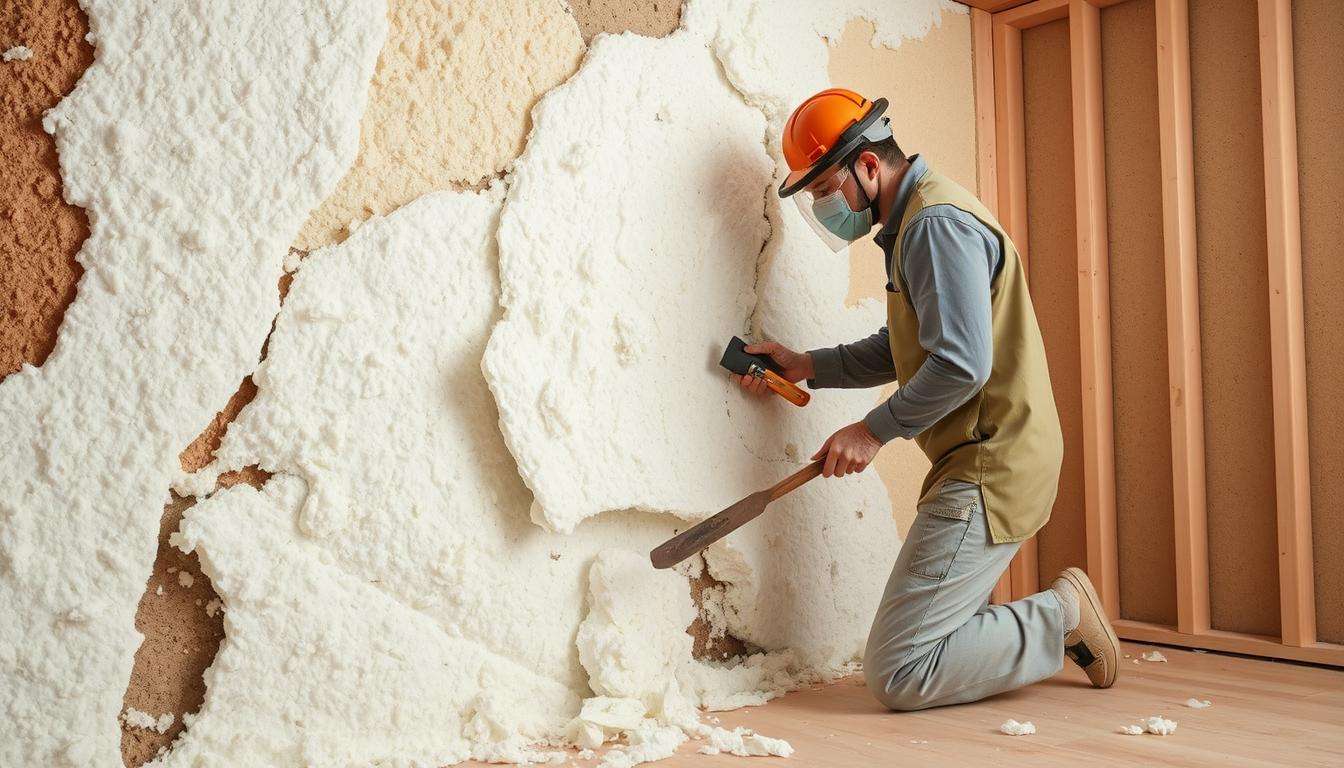Welcome to our expert guide on how to remove spray foam insulation! This task might be needed for many reasons. These include bad installation, dampness, or during home makeovers. It’s key to know how spray foam works and the right ways to remove it.
In this guide, we’ll show you how to remove spray foam insulation. We’ll cover the tools and materials you need, safety tips, and a step-by-step guide. This is for DIY fans or anyone wanting a cozier, more energy-efficient home.
If you want help from pros, Green Home Developments has many eco-friendly home solutions. Call them at 0800 156 0880 for advice that fits your needs.
Key Takeaways
- Proper removal methods can solve spray foam insulation problems, making your home more comfortable.
- Important tools include a utility knife, pry bar, and vacuum with a HEPA filter.
- Always wear safety gear like gloves and masks to avoid harmful exposure.
- Clean up well after removing insulation to keep your space safe and neat.
- For expert advice and services, contact professionals like Green Home Developments.
- Regular checks can stop future insulation issues and keep your home energy-efficient.
Understanding Spray Foam Insulation
Spray foam insulation is used a lot in homes. It makes a strong seal. It goes on walls, roofs, and floors. This makes homes more energy efficient by stopping air leaks.
Knowing about it helps keep homes healthy. It also tells us when it might need to be taken out.
What is Spray Foam Insulation?
Spray foam insulation has two parts: isocyanate and polyol resin. When mixed, they expand. This fills gaps and makes a strong barrier.
There are many types of spray foam. Each is for different needs.
Types of Spray Foam Insulation
Knowing the types of spray foam helps pick the right one. There are three main types:
- Open Cell Spray Foam: It’s flexible and easy to remove.
- Closed Cell Spray Foam: It’s good at keeping moisture out but harder to get rid of.
- Canned Foam: Easy to find, great for small jobs but harder to use than open cell.
Benefits of Spray Foam Insulation
Spray foam insulation has many benefits. It’s a favorite among homeowners. Some key benefits are:
- Energy Efficiency: It seals gaps, saving energy and money on bills.
- Durability: It lasts long and fights off moisture, keeping mold away.
- Eco-Friendliness: New formulas use less bad stuff, making air inside homes better.
Knowing these benefits helps homeowners choose the right insulation. It also tells them when to remove or replace it.
Reasons for Removal
Homeowners often need to remove spray foam insulation for important reasons. Knowing these reasons helps make smart choices about insulation.
Damage and Deterioration
Spray foam insulation is tough but can get damaged. Here are some main reasons for removing it:
- Pests, like rodents or insects, can harm the insulation.
- Moisture can damage the insulation, causing mold and decay.
- Fire damage might mean the insulation needs to be taken out.
- Natural disasters, like floods or hurricanes, can also require insulation removal.
Allergies and Health Concerns
Bad installation or old foam can hurt air quality. Homeowners might worry about these health issues:
- Badly installed foam can trap pollutants, making indoor air worse.
- Health problems from foam insulation can come from VOCs.
- Allergies or breathing issues might make people think about changing insulation.
Home Renovations
Home improvements often mean removing spray foam insulation. Here’s why:
- Upgrading insulation for better energy use.
- Switching insulation types for better warmth.
- Renovations might need insulation removal for space changes.
Tools and Materials Needed
Before you start removing spray foam insulation, you need the right tools and materials. Getting ready right helps you work better and stay safe.
Essential Tools for Removal
Choosing the right tools makes removing spray foam easier. Here are some you might need:
- Serrated knives for precise cuts
- Pry bars to help lift foam away
- Utility knives for more stubborn patches
- Reciprocating saws for tougher areas or dense foam
Safety Gear and Precautions
Wearing safety gear is key to avoid health problems from insulation. Always wear:
- Gloves to protect your hands
- Goggles to keep your eyes safe from debris
- Dust masks or respirators to keep out particles and vapors
Make sure the area is well-ventilated. Open windows or use fans to move air around.
Cleaning Supplies
Have cleaning supplies ready for after the job. You’ll need:
- A vacuum with a HEPA filter to catch dust
- Solvents like acetone to clean up adhesive
- Mineral oil as a cheap way to clean

Step-by-Step Removal Process
Removing spray foam insulation needs a careful plan. Follow these steps for a smooth process. This way, you avoid damaging your property.
Preparing the Area
Before you start, preparing an area for foam removal is key. Here’s what to do:
- Clear the space by taking out all furniture and items.
- Cover the floors with protective sheets to catch debris.
- Turn off electrical parts and the HVAC system for safety.
- Wear goggles, masks, and gloves to protect yourself.
Cutting the Foam
Use a utility knife or insulation saw to cut the foam. Start at one edge and work your way through. Make sure not to cut into the walls or ceilings.
Removing the Foam
After cutting, use a pry bar to lift big sections. For small pieces, a vacuum helps remove them without damage. This careful method keeps the area safe for future use.
| Step | Action | Tools Required |
|---|---|---|
| 1 | Preparing the area | Protective sheets, gloves, goggles |
| 2 | Cutting foam | Utility knife, insulation saw |
| 3 | Removing foam | Pry bar, vacuum |
Disposal of Spray Foam Insulation
After removing spray foam insulation, it’s important to dispose of it right. This keeps you in line with local rules and helps the planet. Knowing the rules and eco-friendly ways to get rid of it is key.
Local Disposal Regulations
Every area has its own rules for getting rid of spray foam. It’s up to homeowners to learn these rules. This way, you can avoid fines and keep your community safe.
Always talk to your local waste team. They can tell you:
- How to dispose of spray foam
- Rules for hazardous waste
- If you need special permits
Eco-Friendly Disposal Options
Looking for ways to dispose of foam that’s good for the planet? Here are some ideas:
- Recycling places that take foam
- Services that handle chemical waste safely
- Groups that reuse foam materials
Choosing eco-friendly ways to get rid of foam is good for everyone. It helps your community and the planet too.
| Disposal Method | Pros | Cons |
|---|---|---|
| Regular Trash | Cured foam is inert and accepted as regular waste. | Not applicable for liquid or uncured foam. |
| Hazardous Waste Facility | Ensures safety when dealing with liquid components and chemicals. | May require special handling and fees. |
| Recycling Programs | Reduces environmental impact. | Not all areas have recycling options for foam. |
Repairing Damaged Surfaces
After removing spray foam insulation, you need to fix any damage. This is key to making your home look good and work right.
Assessing Damage After Removal
Start by checking the area well. Look for any problems on walls and ceilings. You might see:
- Cracks or holes from the foam
- Uneven surfaces that need fixing
- Moisture or mold that must be cleaned
Patching Walls and Ceilings
After finding the damage, start fixing it. Use the right stuff to fix holes to make the repair last. Here’s how:
- Clean the area to get rid of dirt.
- Put on a patching compound or spackling paste.
- Spread the compound with a putty knife, filling all gaps.
- When it’s dry, sand it smooth.
Painting and Finishing
After fixing, it’s time to make it look good again. Here’s what to do:
- Choose a paint that matches the wall or ceiling.
- Prime the fixed areas to seal them.
- Paint with a roller or brush, blending the fixed spots with the rest.
By fixing surfaces after foam removal, you keep your home looking and working great.

Professional Removal Services
When spray foam insulation is a problem, you might need professional help. Not all jobs are right for DIY. Knowing when to call in the pros is key for a safe job.
When to Hire a Professional
Think about hiring a pro when:
- Insulation is complex or badly damaged.
- Mold, pests, or allergens are making your air bad.
- You need special skills for different insulation types.
Costs of Professional Services
How much pros cost depends on:
- How big and tricky the job is.
- Where you live and local prices.
- How bad the mess is and what materials are involved.
Get quotes from several to find the best deal.
Benefits of Hiring Experts
Experts bring many benefits:
- They know how to remove all kinds of insulation safely.
- They use special tools and safety gear to protect you.
- They work fast, saving you time and hassle.
- They make sure everything is done right and safely thrown away.
Preventing Future Problems
To keep your home comfy and healthy, it’s key to stop spray foam issues before they start. Good insulation and regular upkeep can save you money and keep you safe.
Proper Insulation Practices
First, get a pro to install spray foam insulation. They know how to do it right, which lowers risks. Here are some tips:
- Choose a trusted contractor to avoid problems later.
- Learn about different foam types, like open-cell and closed-cell, to pick the best for your home.
- Go for eco-friendly options like cellulose or mineral wool. They’re safer and easier to care for.
Regular Inspections and Maintenance
Check your insulation often to catch issues early. Here’s what to do:
- Check your insulation yearly to see how it’s doing.
- Watch for moisture, mold, or breathing problems. These could mean the foam is off-gassing or breaking down.
- Keep records of any changes or damage. This can help with property value issues later.
Frequently Asked Questions
Homeowners often wonder about spray foam insulation. They ask many questions. Let’s answer some of these to help you understand it better.
How long does spray foam insulation last?
Spray foam insulation can last 20 to 30 years. This depends on how well it’s installed and the environment. It keeps your home energy-efficient for a long time.
Can I reuse spray foam insulation?
It’s not good to reuse spray foam insulation. It cures and can get dirty. If you need to remove it, put in new foam. This is especially true if you want better insulation.
Is spray foam insulation safe?
Spray foam insulation is safe if installed right. But, bad installation can harm air quality. Always follow the rules and use good ventilation. For more info, read this article about spray foam.
